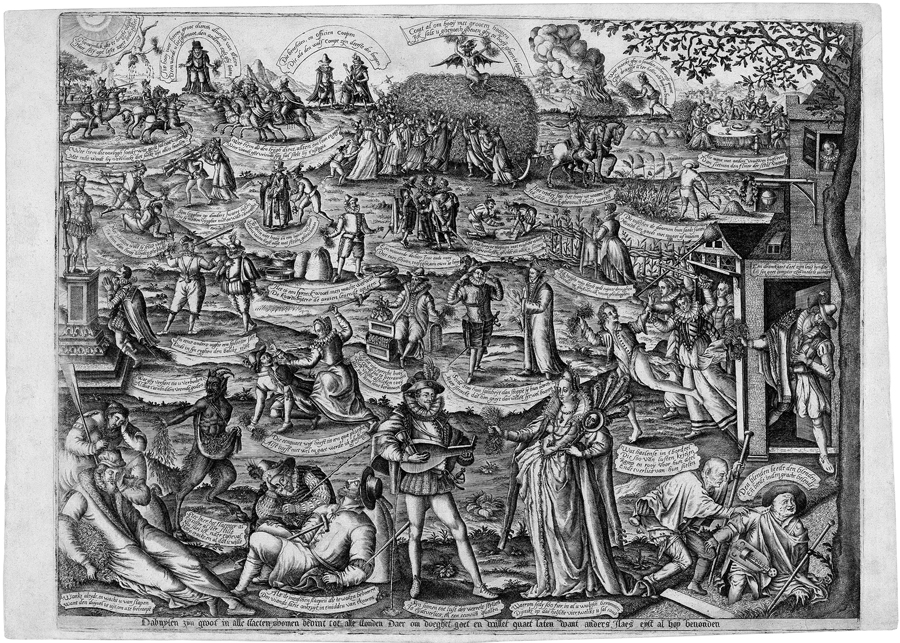Loading the page ...
Jacques Horenbault
(fl. c. 1608 in Ghent)
Allegory of the Vices. Etching. 39.2 x 51.3 cm. (1608). Hollstein 1.
This portrayal of Flemish proverbs and folk sayings is an extremely rare example of a pictorial tradition very popular in the south of the Low Countries since the late 1550s and persisting well into the next century. The prototype for this kind of picture was Frans Hogenberg’s 1558 etching De blauwe Huick, which in the following decades was to be the model for a large number of original prints and related variants.
In this specific case we are dealing with a free adaptation of an allegorical print published by Bartholomeus de Momper of Antwerp in 1559. It refers to a collection of proverbs concerning human vices and bearing the enigmatic title Al Hoy (All is Hay). However the author of this print, Jacques Horenbault, modified de Momper’s original fifty years later in several respects by updating the figures’ costumes and making a number of compositional changes. The main difference, however, lies in the fact that Horenbault replaced several anticlerical scenes and captions from the original 1559 version with less controversial portrayals that did not feature members of the clergy. His conduct in this regard reflects the changed and repressive intellectual climate of the Counter-Reformation in his homeland (see Louis Lebeer, “Het hooi en de hooiwagen in de beeldende Kunsten”, Gentsche Bijdragen tot de Kunstgeschiedenis., V, 1938, pp. 141–155).
In this print too we are confronted with a veritable plethora of human vices that Horenbault presents with evident relish and narrative flair. On a wide plain a large number of men and women are assembled to engage in vain and sinful pursuits. Interestingly enough, it is mainly finely attired lords and ladies and prosperous burghers who are portrayed, while members of the lower estates are clearly in the minority. On the horizon we discern the real iconographic leitmotiv of the allegory: a hay wagon drawn by two horses, driven by devils and pursued by a noisy throng who are trying to snatch handfuls of hay from it. This pictorial invention goes back to the Hay Wagon triptych painted by Hieronymus Bosch (Museo del Prado, Madrid) between 1490 and 1500, which clearly shows that in the early 17th century the latter artist’s fame was still undimmed. His highly original invention symbolizes humanity’s desire for transient earthly goods and the avarice this breeds. In keeping with the motto of the original version by Bartholomeus de Momper everything in the picture revolves around “hay” and hence many of the protagonists are pointedly holding bundles of cut grass in their hands. Although the range of meanings covered by the word “hay” in the vernacular speech of the 16th century was very wide, it developed over time into a synonym for sinfulness and deception. The motto “Al Hoy” suggests that sin is to be encountered everywhere (see Jan Grauls, “Taalkundige toelichting bij het hooi en de hooiwagen”, Gentsche Bijdragen tot de Kunstgeschiedenis, V, 1938, pp. 156–177). In the centre foreground a lute-playing nobleman and a courtesan represent idleness and vanity. In numerous little individual scenes the seven deadly sins – Pride, Avarice, Lust, Wrath, Gluttony, Envy and Sloth – are depicted in a vivid, sometimes earthy manner, which no doubt contributed to the great popularity of this kind of prints. Horenbault’s meticulous etching style proves to be a suitable instrument for regaling the viewer with a wealth of amusing anecdotal details. It is interesting to note that, in depicting the parable of the blind leading the blind in the right foreground, the artist adapted the 1559 prototype by replacing the original, based on Pieter Brueghel’s design, by an almost identical repetition of Pieter van der Heyden’s engraving after Hieronymus Bosch (Hollstein 21, fig. 1). In this way Horenbault paid a further tribute to his great predecessor. Next to nothing is known about the author of this print, who came from a family of artists active in Ghent from the late 15th century. Hollstein was only familiar with the present etching and only able to prove the existence of one impression, which is kept in Amsterdam’s Rijksprentenkabinet.
A very fine, strong and contrasting early inmpression with margins around the platemark; before the artist’s address (which is present on the Amsterdam impression) and before the date. In impeccable condition.
